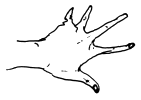
[F]unctions are never intrinsic to the physics of any phenomena but are assigned from outside by conscious observers and users. Functions, in short, are never instrinsic but always observer relative. . . . It is, for example, intrinsic to nature that the heart pumps blood, and causes it to course through the body. It is also an intrinsic fact of nature that the movement of blood is related to a whole lot of other causal processes having to do with the survival of the organization. But when, in addition to saying 'The heart pumps blood' we say, 'The function of the heart is to pump blood,' we are doing something more than recording these intrinsic facts. We are situating these facts relative to a system of values that we hold. It is intrinsic to us that we hold these values, but the attribution of these values to nature independent of us is observer relative. Even when we discover a function in nature, as when we discovered the function of the heart, the discovery consists in the discovery of the causal processes together with the assignment of a teleology to those causal processes. This is shown by the fact that a whole vocabulary of success and failure is now appropriate that is not appropriate to simple brute facts of nature. Thus we can speak of 'malfunction,' 'heart disease,' and better and worse hearts. We do not speak of better or worse stones, unless of course we have assigned a function to the stone. . . . We do indeed 'discover' functions in nature. But the discovery of a natural function can take place only within a set of prior assignments of value (including purposes, teleology, and other functions) (14-15).
The central span on the bridge from physics to society is collective intentionality, and the decisive movement on that bridge in the creation of social reality is the collective intentional imposition of function on entities that cannot perform those functions without that imposition (41).
If . . . we give a big cocktail party, and invite everyone in Paris, and if things get out of hand, and it turns out that the casualty rate is greater than the Battle of Austerlitz -- all the same, it is not a war; it is just one amazing cocktail party. Part of being a cocktail party is being thought to be a cocktail party; part of being a war is being thought to be a war. This is a remarkable feature of social facts; it has no analogue among physical facts (33-34).
Institutional facts . . . are a special subclass of social facts. Congress passing legislation is an institutional fact; hyenas hunting a lion is not (38).
-- John R. Searle, The Construction of Social Reality (New York: Free Press, 1995).